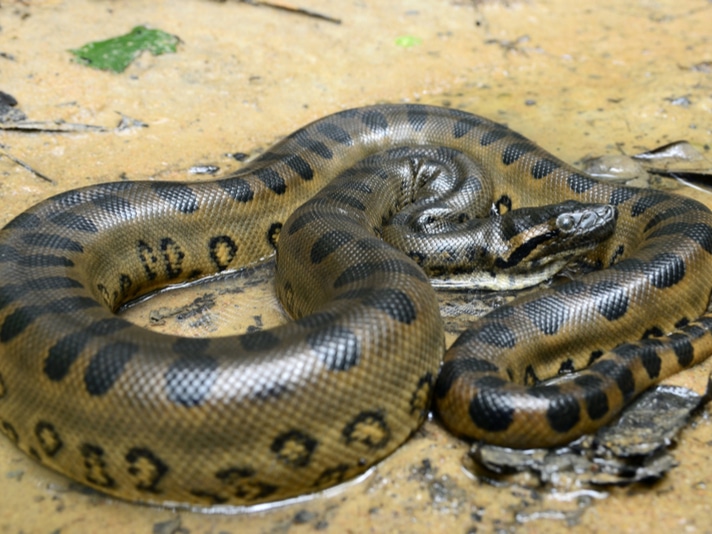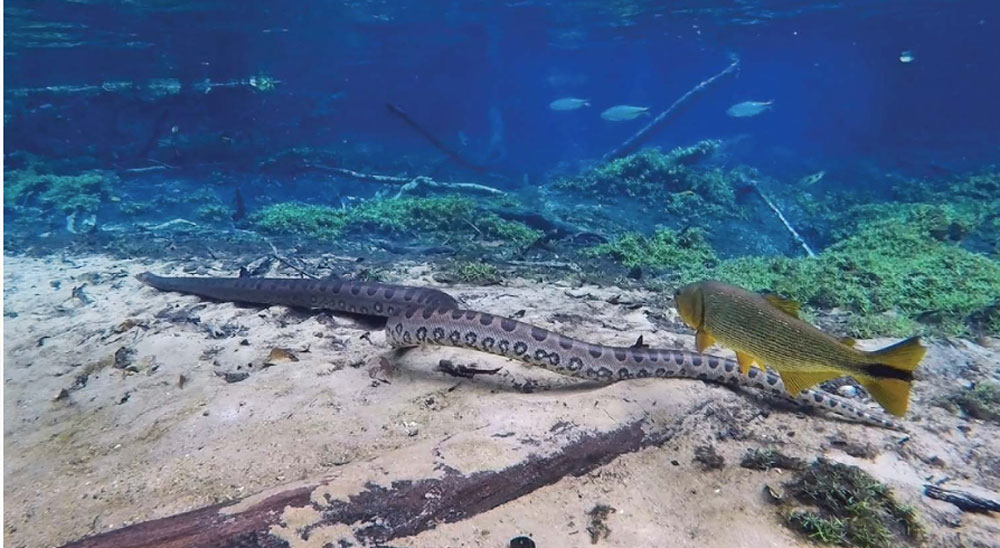The golden dorado was observed following the green anaconda on four separate occasions.
Researchers in Brazil have observed on four different occasions, instances of the golden dorado (Salminus brasiliensis), a freshwater fish, closely following the green anaconda (Eunectes murinus), as the large constricting snake swims in a clear water river in midwest Brazil. The researches say the observations are indirect evidence of what is called “nuclear-follower feeding association.”
This is a condition that occurs when a follower of an animal approaches the followed animal, or nuclear animal, as the lead animal disturbs the substrate and forms sediment could as they forage, which gives the follower animal the capability to feed. While the observations occurred, the researchers stress that there was no benefit to the golden dorado from following the reptile.
The observations occurred in the Olho d’Água River, which runs through the Bodoquena Plateau in Midwest Brazil. The river is part of the Paraguay River watershed. The water is high in alkalinity and low turbidity with visibility exceeding 30 meters. Initial records were made while snorkeling with video used to record the interactions for further analysis. The scientists recorded four interactions between the two species in August 2006, June 2018, November 2019, and June 2021. In each case, the golden dorado followed the green anaconda from behind, near the tail. The observations lasted about 10 minutes each, with other fish species temporarily following the green anaconda.
Two Anaconda Born Via Parthenogenesis At New England Aquarium
While the researchers did not record any feeding behaviors of the golden dorado, they speculate that the disturbance of the substrate by the green anaconda could present a feeding event to the golden dorado, as the disturbances could disrupt certain species of fish that the golden dorado could eat, including piraputanga (Brycon hilarii), tetras (A. lacustris), curimbatas (P. lineatus) and piranhas (S. maculatus).

The green anaconda grows to about 15 feet in length. Photo by Patrick K. Campbell/Shutterstock
The researchers do note that future observations could bring interesting information about this association between fish and snakes. In reef settings, this type of association is well documented. The study presents indirect evidence of this type of association between the two species and discuss what may motivate this type of interspecific interaction to occur and how it may converge with existing observations with other species.
The complete study, “Indirect evidence of following association between golden dorados (Salminus brasiliensis) and green anacondas (Eunectes murinus) in a Clearwater river of Midwest Brazil” can be read on the Biota Neotropica website.
Green Anaconda Information
Green anacondas are large, heavy-bodied snakes that can grow to about 15 feet give or take a few feet. This snake is probably the most widely mythologized of the large constrictors due in part to old television shows and movies that depicted them as massive, monstrous reptiles that devour anything that moves. They have been reported to be, erroneously, the largest snakes in the world. They aren’t. In the Americas, they are, unless you count the invasive Burmese pythons of the Florida Everglades.


